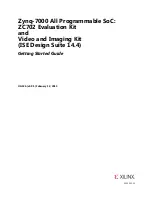
4-42
F35 MULTIPLE FEEDER PROTECTION SYSTEM – INSTRUCTION MANUAL
FRONT PANEL INTERFACE
CHAPTER 4: INTERFACES
4
•
TEST MODE
— Indicates that the relay is in test mode. For information, see the Test Mode section in the Settings
chapter.
•
TRIP
— Indicates that the selected FlexLogic operand serving as a trip switch has operated. This indicator always
latches; initiate the reset command to reset the latch.
•
ALARM
— Indicates that the selected FlexLogic operand serving as an alarm switch has operated. This indicator never
latches.
•
PICKUP
— Indicates that an element is picked up. This indicator never latches.
Event-cause indicators
Event-cause LEDs are turned on or off by protection elements that have their respective target setting selected as either
“Enabled” or “Latched.” If a protection element target setting is “Enabled,” then the corresponding event cause LEDs
remain on as long as the operand associated with the element remains asserted. If a protection element target setting is
“Latched,” then the corresponding event cause LEDs turn on when the operate operand associated with the element is
asserted and remains on until the
RESET
button on the front panel is pressed after the operand is reset.
All elements that are able to discriminate faulted phases can independently turn off or on the phase A, B, or C LEDs. This
includes phase instantaneous overcurrent, phase undervoltage, and so on. This means that the phase A, B, and C operate
operands for individual protection elements are ORed to turn on or off the phase A, B, or C LEDs.
•
VOLTAGE
— Indicates voltage was involved
•
CURRENT
— Indicates current was involved
•
FREQUENCY
— Indicates frequency was involved
•
OTHER
— Indicates a composite function was involved
•
PHASE A
— Indicates phase A was involved
•
PHASE B
— Indicates phase B was involved
•
PHASE C
— Indicates phase C was involved
•
NEUTRAL/GROUND
— Indicates that neutral or ground was involved
User-programmable indicators
The second and third panels provide 48 amber LED indicators whose operation is controlled by the user. Custom labelling
can be done.
User customization of LED operation is of maximum benefit in installations where languages other than English are used
to communicate with operators. See the User-programmable LEDs section in chapter 5 for the settings used to program
the operation of the LEDs on these panels.
Figure 4-49: LED panels 2 and 3 (index template)
Default labels for LED panel 2
The default labels are intended to represent the following:
•
GROUP 1...6
— The illuminated GROUP is the active settings group
•
RECLOSE ENABLED
— The recloser is operational
















































